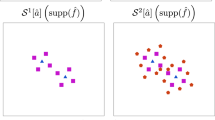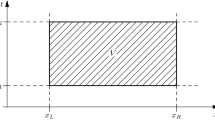Abstract
In this paper we propose a surrogate model for advection–diffusion–reaction problems characterized by a dominant direction in their dynamics. We resort to a hierarchical model reduction where we couple a modal representation of the transverse dynamics with a finite element approximation along the mainstream. This different treatment of the dynamics entails a surrogate model enhancing a purely 1D description related to the leading direction. The coefficients of the finite element expansion along this direction introduce a generally non-constant description of the transversal dynamics. Aim of this paper is to provide an automatic adaptive approach to locally select the dimension of the modal expansion as well as the finite element step in order to satisfy a prescribed tolerance on a goal functional of interest.













Similar content being viewed by others
Notes
We usually set \(\widetilde{m}^+=m+2\); due to the parity of sinusoidal functions, the simplest choice \(\widetilde{m}^+=m+1\) is completely useless when dealing with solutions symmetric with respect to fiber \(\Omega _{1D}\).
References
Achchab, B., Achchab, S., Agouzal, A.: Some remarks about the hierarchical a posteriori error estimate. Numer. Methods Partial Differ. Equ. 20(6), 919–932 (2004)
Ainsworth, M.: A posteriori error estimation for fully discrete hierarchic models of elliptic boundary value problems on thin domains. Numer. Math. 80, 325–362 (1998)
Arnold, D.N., Brezzi, F., Cockburn, B., Marini, L.D.: Unified analysis of discontinuous Galerkin methods for elliptic problems. SIAM J. Numer. Anal. 39, 1749–1779 (2002)
Bangerth, W., Rannacher, R.: Adaptive Finite Element Methods for Differential Equations. Birkhauser Verlag, Basel (2003)
Bank, R.E., Smith, R.K.: A posteriori error estimates based on hierarchical bases. SIAM J. Numer. Anal. 30, 921–935 (1993)
Becker, R., Rannacher, R.: An optimal control approach to a posteriori error estimation in finite element methods. Acta Numer. 10, 1–102 (2001)
Bernardi, C., Maday, Y., Patera, A.T.: Domain decomposition by the mortar element method. NATO Adv. Sci. Inst. Ser. C Math. Phys. Sci., vol. 384. Kluwer, Dordrecht (1993)
Blanco, P.J., Leiva, J.S., Feijóo, R.A., Buscaglia, G.C.: Black-box decomposition approach for computational hemodynamics: one-dimensional models. Comput. Methods Appl. Mech. Eng. 200(13–16), 1389–1405 (2011)
Braack, M., Ern, A.: A posteriori control of modeling errors and discretization errors. Multiscale Model Simul. 1, 221–238 (2003)
Bruckstein, A.M., Donoho, D.L., Elad, M.: From sparse solutions of systems of equations to sparse modeling of signal and images. SIAM Rev. 51(1), 34–81 (2009)
Ciarlet, Ph: The Finite Element Method for Elliptic Problems. North-Holland, Amsterdam (1978)
Clément, Ph: Approximation by finite element functions using local regularization. RAIRO Anal. Numer. 2, 77–84 (1975)
Cnossen, J.M., Bijl, H., van Brummelen, E.H.: Model-error estimation for goal-oriented model adaptation in flow-simulations. Finite volumes for complex applications IV, 173–183 (2005)
Dahmen, W., Kurdila, A.J., Oswald, P. (eds.): Multiscale Wavelet Methods for Partial Differential Equations. Wavelet Analysis and Its Applications, vol. 6. Academic Press, San Diego (1997)
Dörfler, W., Nochetto, R.H.: Small data oscillation implies the saturation assumption. Numer. Math. 91, 1–12 (2002)
Ern, A., Perotto, S., Veneziani, A.: Hierarchical model reduction for advection–diffusion–reaction problems. In: Kunisch, K., Of, G., Steinbach, O. (eds.) Numerical Mathematics and Advanced Applications, pp. 703–710. Springer, Berlin (2008)
Formaggia, L., Nobile, F., Quarteroni, A., Veneziani, A.: Multiscale modelling of the circulatory system: a preliminary analysis. Comput. Visual. Sci. 2, 75–83 (1999)
Formaggia, L., Quarteroni, A., Veneziani, A. (eds.): Cardiovascular Mathematics: Modeling and Simulation of the Circulatory System. Modeling Simulation and Applications, vol. 1. Springer, Milano (2009)
Giles, M.B., Süli, E.: Adjoint methods for PDEs: a posteriori error analysis and postprocessing by duality. Acta Numer. 11, 145–236 (2002)
Hinze, M., Volkwein, S.: Proper orthogonal decomposition surrogate models for nonlinear dynamical systems: error estimates and suboptimal control. In: Dimension Reduction of Large-Scale Systems. Lect. Notes Comput. Sci. Eng., vol. 45, pp. 261–306. Springer, Berlin (2005)
Johnson, C.: A new paradigm for adaptive finite element methods. In: Whiteman, J. (eds.) Proceedings of MAFELAP 93. Wiley, New York (1993)
Lacour, C., Maday, Y.: Two different approaches for matching nonconforming grids: the mortar element method and the FETI method. BIT 37, 720–738 (1997)
Lasis, A., Süli, E.: Poincaré-type inequalities for broken Sobolev spaces. Tech. Report 03-10, Oxford University Computing Laboratory (2003)
Lions, J.L., Magenes, E.: Non Homogeneous Boundary Value Problems and Applications. Springer, Berlin (1972)
Maday, Y., Ronquist, E.M.: A reduced-basis element method. C. R. Acad. Sci. Paris Ser. I(335), 195–200 (2002)
Micheletti, S., Perotto, S., David, F.: Model adaptation enriched with an anisotropic mesh spacing for nonlinear equations: application to environmental and CFD problems. Numer. Math. Theor. Meth. Appl. 6(3), 447–478 (2013)
Miglio, E., Perotto, S., Saleri, F.: Model coupling techniques for free-surface flow problems. Part I. Nonlinear Anal. 63, 1885–1896 (2005)
Oden, J.T., Prudhomme, S.: Goal-oriented error estimation and adaptivity for the finite element method. Comput. Math. Appl. 41, 735–756 (2001)
Oden, J.T., Prudhomme, S.: Estimation of modeling error in computational mechanics. J. Comput. Phys. 182, 469–515 (2002)
Oden, J.T., Prudhomme, S., Hammerand, D.C., Kuczma, M.S.: Modeling error and adaptivity in nonlinear continuum mechanics. Comput. Methods Appl. Mech. Eng. 190, 6663–6684 (2001)
Oden, J.T., Vemaganti, K.S.: Estimation of local modeling error and goal-oriented adaptive modeling of heterogeneous materials. I. Error estimates and adaptive algorithms. J. Comput. Phys. 164(1), 22–47 (2000)
Ohlberger, M., Smetana, K.: A new problem adapted hierarchical model reduction technique based on reduced basis methods and dimensional splitting. Tech. Report 03-10, University Muenster (2010)
Perotto, S.: Adaptive modeling for free-surface flows. M2AN Math. Model. Numer. Anal. 40(3), 469–499 (2006)
Perotto, S.: Hierarchical model (Hi-Mod) reduction in non-rectilinear domains. In press: Proceedings of the 21st International Conference on Domain Decomposition Methods. Springer, Berlin (2013)
Perotto, S., Ern, A., Veneziani, A.: Hierarchical local model reduction for elliptic problems: a domain decomposition approach. Multiscale Model. Simul. 8(4), 1102–1127 (2010)
Quarteroni, A., Valli, A.: Domain Decomposition Methods for Partial Differential Equations, Numerical Mathematics and Scientific Computation. Oxford University Press, New York (1999)
Robertson, A.M., Sequeira, A.: A director theory approach for modeling blood flow in the arterial system: an alternative to classical 1D models. Math. Models Methods Appl. Sci. 15(6), 871–906 (2005)
Stein, E., Rüter, M., Ohnimus, S.: Error-controlled adaptive goal-oriented modeling and finite element approximations in elasticity. Comput. Methods Appl. Mech. Eng. 196, 3598–3613 (2007)
Toselli, A., Widlund, O.: Domain Decomposition Methods–Algorithms and Theory. Springer, Berlin (2005)
Vogelius, M., Babuška, I.: On a dimensional reduction method. III. A posteriori error estimation and an adaptive approach. Math. Comp. 37, 361–384 (1981)
Acknowledgments
The authors wish to thank warmly Alexandre Ern for many discussions and fundamental suggestions he gave along the entire preparation of the manuscript.
Author information
Authors and Affiliations
Corresponding author
Additional information
This work has been partially supported by the PRIN 2010–2011 project “Innovative methods for water resources management under hydro-climatic uncertainty scenarios”.
Rights and permissions
About this article
Cite this article
Perotto, S., Veneziani, A. Coupled Model and Grid Adaptivity in Hierarchical Reduction of Elliptic Problems. J Sci Comput 60, 505–536 (2014). https://doi.org/10.1007/s10915-013-9804-y
Received:
Revised:
Accepted:
Published:
Issue Date:
DOI: https://doi.org/10.1007/s10915-013-9804-y




